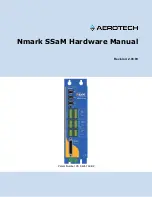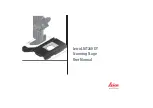
Pressure Systems, Inc. Model 9116 User’s Manual
Page 19
www.PressureSystems.com
directed to “well-known” port 9000 (default). After the connection is made, a
socket
is
established as a logical handle to this connection. The host and module may then
communicate, via this
socket,
until it is closed or is lost at either module or host end, due to
power failure or reboot). The host and module may also communicate in a limited fashion
without a connection
, using the middle-level UDP/IP protocols. In that case, the host simply
broadcasts commands via port 7000, and each module (that chooses to respond) returns the
response on port 7001. Only a few commands use UDP/IP in
Model 9116
modules.
3.1.2
Commands
The commands (and responses) used by
Model 9116
modules consist of short strings of ASCII
characters. The TCP/IP and UDP/IP protocols allow for the transfer of either printable ASCII
characters or binary data. When using certain formats, internal binary data values are often
converted to ASCII-hex digit strings externally. Such values may include the ASCII number
characters ‘0’ through ‘9,’ the
uppercase
ASCII characters ‘A’ through ‘F,’ and the
lowercase
letters ‘a’ through ‘f’.’ These hex values may represent bit maps of individual options, or actual
integer or floating point (IEEE) binary data values. In other cases (see optional
format 7
below)
binary data may be transmitted directly as 4-byte (32-bit) binary values without any formatting
change. Such binary transmissions use big-endian (default) byte ordering but may be
commanded to use little-endian for some data.
3.1.2.1
General Command Format
A typical TCP/IP command (contained in the data field following a TCP packet header) is a
variable-length character string with the following general fields:
!
a
1-character
command letter (c)
.
!
an
optional
position
field
(pppp)
, a variable length string of hexadecimal digits.
!
a variable number of optional
datum
fields
( dddd)
: each a variable length string,
normally
formatted as a decimal number (with a leading
space
character, and with or without
sign
and/or
decimal point
, as needed).
Using brackets ( [ ] ) to show optional elements, and ellipsis ( ...) to show indefinite repetition, a
typical TCP/IP command may be viewed schematically as follows:
“c[[[[
p
]
p
]
p
]
p
][
dddd
][
dddd
]...]”
From this schematic, it should be clear that the
command letter
(c) is required, the
position
field
(
pppp
) immediately follows it, and may have 0, 1, 2, 3, or 4 characters, and there may be zero
or more
datum
fields (
dddd
), as required. For simplicity, the variable length nature of each “
dddd
” string is not shown [with brackets] above, but the required leading space character is
shown. The
position
field is similarly simplified (as “
pppp
”) below.















































